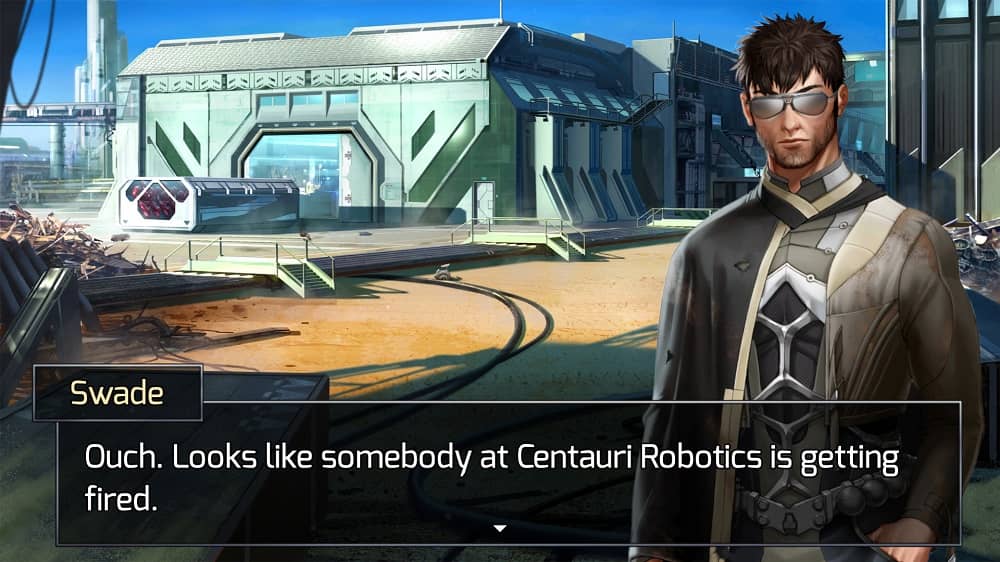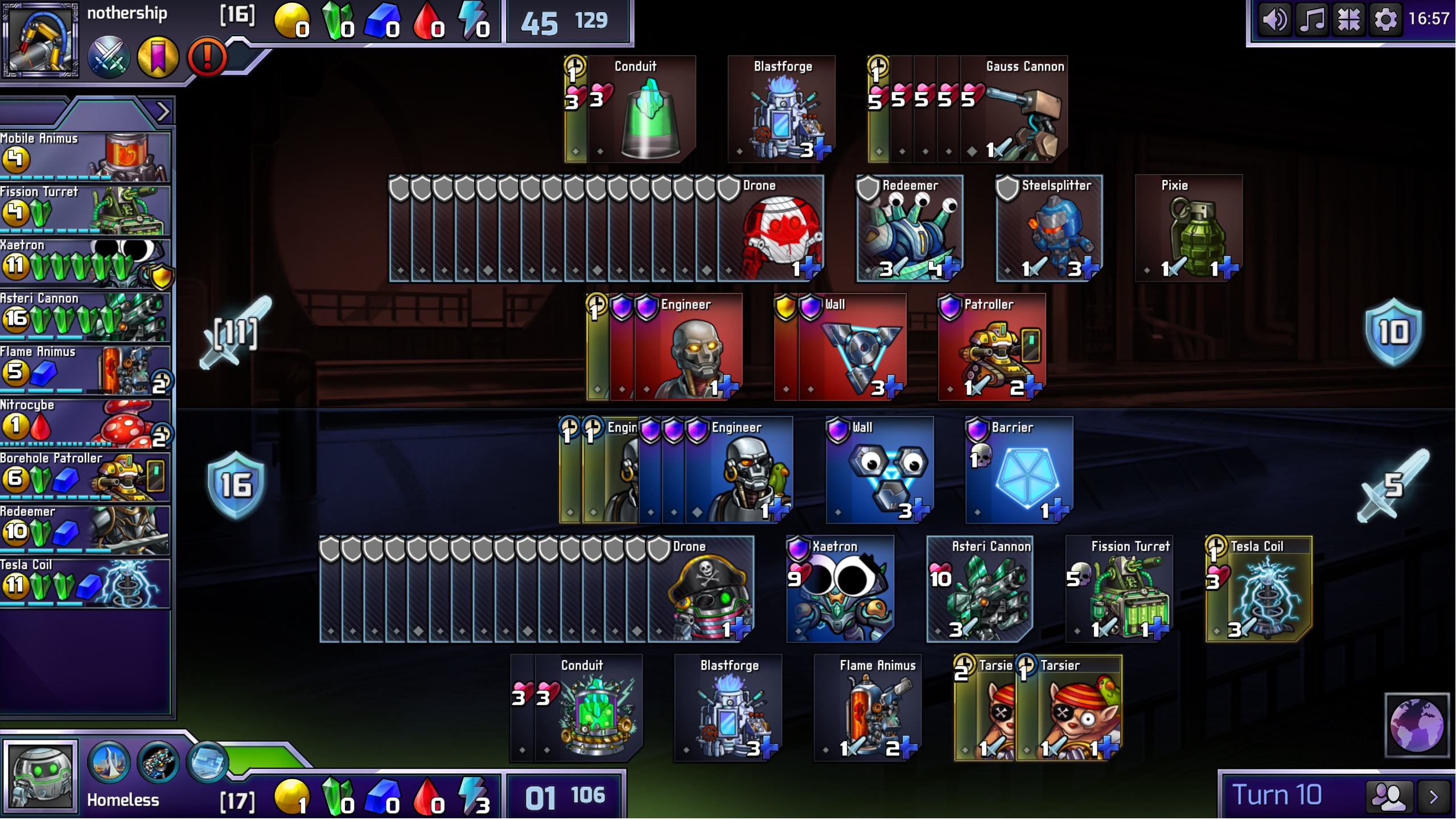Search
[{{{type}}}] {{{reason}}}
{{/data.error.root_cause}}{{{_source.title}}} {{#_source.showPrice}} {{{_source.displayPrice}}} {{/_source.showPrice}}
{{#_source.showLink}} {{/_source.showLink}} {{#_source.showDate}}{{{_source.displayDate}}}
{{/_source.showDate}}{{{_source.description}}}
{{#_source.additionalInfo}}{{#_source.additionalFields}} {{#title}} {{{label}}}: {{{title}}} {{/title}} {{/_source.additionalFields}}
{{/_source.additionalInfo}}- Details
- Category: Computer
- By Cinque Pierre
- Hits: 3190
Prismata (PC) (Preview)

Prismata
Developed By: Lunarch Studios
Published By: Lunarch Studios
Released: March 8, 2018 (Early Access)
Available On: macOS, Windows, Web Browser
Genre: Strategy
ESRB Rating: Not Rated
Number of Players: up to two players
Price: Free to play (Lite Edition); $24.99 (Founder’s Pack)
Thank you, Lunarch Studios, for sending us a preview code!
Note: At the time we received a code, the game was only in a “pay-to-play” state
Prismata is a very strange game as it doesn't belong to any existing subgenre. It combines real-time strategy elements, deckbuilding elements through over a hundred different units, and the interface of a board game. The main goal of Prismata is to eliminate all forces on the opposing side of the board while protecting yours. It’s a surprisingly simple concept but the way it is executed is nothing of the sort.
The way Prismata does its tutorial is through its story mode. Many multiplayer-focused games do use their single-player portion to ease people into the player vs. player aspect so this in itself isn’t a unique concept. There is a story mode, split into five episodes. The main plotline is that in the distant future there are human commanders that control legions of robots called Swarmbringers. They defend society from rogues, bandits, and everything bad in-between. For reasons unknown, the very robots Swarmbringers use to defend humanity start to malfunction and attack the very beings they were programmed to protect. It is up to the Swarmbringers to find out the cause of this problem.
Swade is our main character in the campaign portion. He is a cocky, foul-mouthed Swarmbringer who may not have nice things to say most of the time and is pretty easy to upset, but he has humanity’s best interests in heart. He is joined by his assistants, Logan and Giselle. Logan is Swade’s right-hand man who is always there to accompany him during his missions. Giselle is the robot companion of Swade and Logan. Throughout the campaign, Swade will be accompanied by other characters, such as Anya, another Swarmbringer from a different faction. The best way to describe Prismata’s tone is very “Marvel Cinematic Universe-inspired.” There is this general witty banter between characters, and characters will drop quips at seemingly serious moments. The dialogue will even find itself in the middle of battle through optional text boxes/character portraits. Whether you find MCU humor your kind of thing is up to you. For those who greatly dislike that kind of comedy, cutscenes can be skipped.

Strong Points: Interesting combination of board games, deckbuilding, and real-time strategy elements; great character art; no “pay-to-win” elements; an extensive tutorial that explains every feature of the game
Weak Points: The playerbase is dwindling so all who are left in the multiplayer are people who have hundreds or even thousands of hours invested; most cosmetics don’t have much appeal to them
Moral Warnings: Language ranging from “d*mn”, “h*ell”, “dumb**ses”, and “sh*t”; one female character shows off cleavage; the red units are cyborgs, which are explained as having their free will extracted from them
Getting into the actual gameplay portion, the entire first chapter of the campaign acts as a tutorial where it slowly introduces mechanics to you, where some missions have you focus on blocking and defending and others have a focus on offense or building a certain kind of unit. On each side of the board, there are three layers. The top one is where your main blockers and engineers go. They are pure defensive units where you can redirect any damage sent to them. These blockers have a health pool, and to destroy these top-layered blockers, you have to be able to deal the amount of health they have displayed on their unit in damage. For example, if your field has five attack power, and they have two blockers with health of three each, one blocker will be destroyed while the other one will block two points of damage, being able to last for another turn.
The second layer is where your drones and your main attacking units will go. Drones require energy to be built, which are granted by engineers. Drones are also a type of blocking unit, but if clicked on, they will release gold, one of the five main types of currency and one of the two existing forms of currency to persist after a turn ends. All other forms of currency are “wasted” at the end of a turn. Any unclicked drones that aren’t used to farm gold can be used in the defense portion. Your main attacking units also go on this layer. Some have blocking features, while others are "fragile," which means they can be attacked even if your attack power is insufficient to destroy them in one turn. Fragile units make up for this flaw by having a higher health pool in total. Attacking units have an attack power assigned to them and their abilities can vary greatly when clicked, such as adding more attack power (typically at the cost of either gold or being unable to defend), adding more units, or even special unique properties exclusive to that unit.
The last layer is where your other resource building units and specialized units go. The unites that build blue, red, and green resources (also known as Behemium, Replicase, and Gaussite respectively) go here. Specialized units, typically (but not always) units that use red resources go here. Offensive units that go on this layer tend to be passive and grant additional attack power at the start of a turn. Every unit has a limit on how much it can be built before it cannot be used again. Some can be built as many as twenty times and others can be built as few as once.
The simplest way of explaining the metagame is that you have to build up your resources in such a way to produce a “snowballing” effect while preventing your opponent from doing the same. All actions can be controlled by the mouse but there are hotkeys all over the keyboard that quickly do the action that a mouse would do, such as select a specific set of units, undo your last action, or end your turn. Because there are hundreds of units, each with their own health, attack stats, and abilities, knowing what can be done at any time is crucial to victory. Lunarch Studios prides itself on not being pay-to-win, as every unit in the game can be obtained by simply playing and that microtransactions are only used for cosmetics and further campaign missions.
When looking at the character portraits and art, they are surprisingly detailed, with the humans being anatomically correct with proper shading techniques and designed in realism. It’s such a shame that the unit art (the art that you’ll mostly be looking at) is rather amateurish in comparison. Don’t get me wrong, I’m not saying that it is terrible art but it’s more like comparing high school art to art framed in a museum. Even if it would have been time-consuming and costly to make all one hundred-plus units with the detail that the human/robot character art has, I feel it would have grabbed a lot more people’s attention.

Higher is better
(10/10 is perfect)
Game Score - 79%
Gameplay 16/20
Graphics 6.5/10
Sound 7/10
Stability 5/5
Controls 5/5
Morality Score - 82%
Violence 8/10
Language 6/10
Sexual Content 8.5/10
Occult/Supernatural 10/10
Cultural/Moral/Ethical 8.5/10
A lot of the skins amount to color swaps or Photoshop-tier edits, especially the googly-eyes skin that many units have. It not only clashes with many of the designs, but they are also lazily placed on the model itself. Some skins do have effort put into them, as they are more than asset flipping. Some even have animated effects, but a good amount of these skins are ridiculously expensive, ranging up to $35 for just one—and when there are at least five times as many skins as there are units, it will add up.
Considering that this is a strategy game with not a lot of lore surrounding the units themselves, there isn’t a huge amount of moral concerns surrounding it. There technically is violence, but it’s kept to the bare minimum visually. When I mentioned earlier that Prismata shares its brand of humor with the MCU, it also shares its language and crudeness. Swade is the main contributor to the language department as every third or fourth sentence he utters has some kind of swearing in it, ranging from “h*ll”, “d*mn”, “dumb**ses”, and “sh*t.” He also contributes crude humor such as telling Logan to “lick a turd popsicle” in one mission, and takes the sentence “you know what else pops out a bunch of units” in the complete opposite direction (even though the statement was about The Advocate unit and in fact, not a crude joke). A character present in the later campaign missions by the name of Reige shows off a bit of cleavage. Most of the units in the game are robotic in nature, except for the red units. They are all organic in nature, fitted with technology effectively making them cyborgs. Swade and Anya discuss the ethics of ripping away the free will of animals and creatures to use them for combat.
Prismata’s strongest aspect is its gameplay. It is a simple game to get into, but this is not a game for the casual gamer as there is much to master. There are many little things to be mindful of, a lot of resource management, and thinking turns ahead that make this an entry that a hardcore game player will want to invest time into. As of two years since its Early Access release, there are only three episodes of the campaign out and the developers plan to fully release the game once all five episodes are out. If you do happen to like what Prismata offers, a person can easily sink hundreds of hours into it through other single-player modes such as combat training that puts you in preset scenarios, multiple difficulty modes, and of course the multiplayer modes.
Whether Prismata will live long enough for a full release is another question in itself. The cosmetics from a visual perspective as well as a monetary perspective that needs work or preferably an overhaul, as from observation from the few that are still around state themselves that it simply isn’t working. Lunarch Studios chased after a demographic that wanted very little to do with them (the casual audience) and it didn’t work out in their favor. They also boasted that their game is “too smart” which also harmed the image. Prismata is by no means a stupid game, but it doesn’t take quantum physics knowledge to succeed—as the developers at one point embarrassingly boasted. As long as one has a good grasp of mathematics, anyone can beat anyone. Since the game is free-to-play, there is no harm in checking it out. Play through the Chapter 1 tutorial and try out a few combat trials to see if this unique take on the strategy genre is your cup of tea.








